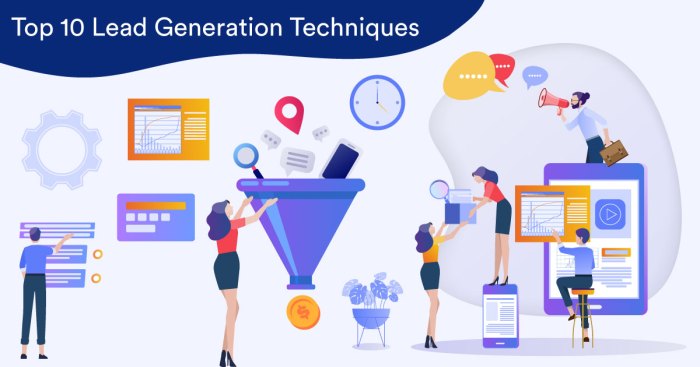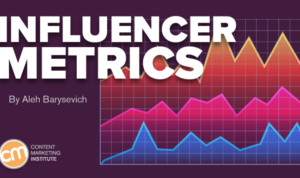Lead Generation Techniques: Get ready to dive deep into the world of capturing leads and boosting your marketing game with strategies that pack a punch. From traditional methods to cutting-edge digital strategies, we’ve got you covered.
Whether you’re a seasoned marketer or just starting out, this guide will equip you with the knowledge and tools needed to take your lead generation to the next level.
Overview of Lead Generation Techniques

Lead generation techniques are crucial in marketing as they help businesses attract potential customers and convert them into leads. These techniques focus on capturing the interest of individuals who have shown some level of interest in a product or service, thus providing valuable leads for the sales team to pursue.
Key Components of an Effective Lead Generation Strategy
- Target Audience Identification: Understanding the specific demographics and behaviors of the target audience is essential for creating personalized and effective lead generation campaigns.
- Compelling Offer: Providing a valuable and relevant offer can entice potential leads to engage with the brand and provide their contact information.
- Multi-Channel Approach: Utilizing various channels such as social media, email marketing, and content marketing can help reach a wider audience and capture leads from different sources.
- Lead Nurturing: Building relationships with leads through personalized communication and providing relevant information can increase the chances of converting them into customers.
Role of Lead Generation in Growing a Business
Lead generation plays a vital role in growing a business by continuously providing a pipeline of potential customers for the sales team to engage with. By implementing effective lead generation strategies, businesses can increase their customer base, boost sales, and ultimately drive revenue growth. Additionally, generating quality leads can help businesses establish long-term relationships with customers and enhance brand loyalty.
Traditional Lead Generation Methods
When it comes to traditional lead generation methods, we can’t ignore the classic techniques like cold calling and direct mail. These methods have been tried and tested for years, but how do they stack up against the modern digital techniques?
Cold Calling
Cold calling involves reaching out to potential leads over the phone without any prior contact. While this method can still be effective in some industries, many people nowadays tend to ignore or block unknown numbers, making it harder to get through to prospects.
Direct Mail
Direct mail, on the other hand, involves sending physical mail pieces to potential leads. This method can be costly and time-consuming, but it can also be more personalized and tangible than digital communication. However, with the rise of email and online marketing, direct mail response rates have declined over the years.
Effectiveness Comparison
When comparing traditional methods like cold calling and direct mail to modern digital techniques such as social media marketing and email campaigns, it’s clear that digital methods often yield higher response rates and are more cost-effective. Digital techniques also allow for better targeting and tracking of leads, making it easier to measure ROI.
Examples of Successful Campaigns
Despite the shift towards digital marketing, there are still examples of successful lead generation campaigns using traditional methods. For instance, a well-executed direct mail campaign with a compelling offer and creative design can still capture the attention of prospects. Similarly, a personalized cold calling approach that focuses on building relationships rather than just pushing sales can lead to valuable connections and conversions.
In conclusion, while traditional lead generation methods have their place in certain industries, businesses should not overlook the power of modern digital techniques in reaching and engaging leads effectively.
Digital Lead Generation Strategies
In today’s digital age, businesses are turning to various online strategies to generate leads and attract potential customers. Digital lead generation involves utilizing popular techniques such as , content marketing, and social media to reach a wider audience and drive engagement.
(Search Engine Optimization)
plays a crucial role in digital lead generation by optimizing a website’s content to rank higher in search engine results. By incorporating relevant s, meta tags, and quality backlinks, businesses can improve their visibility online and attract organic traffic.
Content Marketing
Content marketing involves creating and sharing valuable content, such as blog posts, infographics, and videos, to engage with target audiences and establish authority in a specific industry. By consistently delivering high-quality content, businesses can attract leads and nurture relationships with potential customers.
Social Media
Social media platforms like Facebook, Instagram, and LinkedIn provide valuable opportunities for businesses to connect with their target audience, share content, and drive engagement. By leveraging social media for lead generation, businesses can increase brand awareness, generate leads, and drive conversions.
Optimizing Websites
Optimizing websites for lead generation involves creating user-friendly interfaces, clear call-to-action buttons, and optimized landing pages to capture leads effectively. By designing websites with lead generation in mind, businesses can improve conversion rates and maximize the impact of their digital marketing efforts.
Lead Nurturing Techniques

Lead nurturing is a crucial aspect of the lead generation process, where potential customers are guided through the buyer’s journey with personalized communication to build relationships and increase the chances of conversion.
Personalized Communication
- Segmenting leads based on interests, behavior, and demographics to deliver tailored content.
- Sending targeted emails with relevant information and offers based on lead interactions.
- Using marketing automation tools to schedule and personalize follow-up messages.
Effective Lead Nurturing Campaigns
- Netflix’s personalized recommendation emails based on viewing history.
- Amazon’s targeted product recommendations based on browsing behavior.
- H&M’s exclusive offers to loyalty program members.
Building Relationships for Conversion, Lead Generation Techniques
- By nurturing leads, you establish trust and credibility with potential customers.
- Regular communication helps keep your brand top-of-mind and increases brand loyalty.
- Understanding the needs and preferences of leads allows you to provide relevant solutions, increasing the likelihood of conversion.
Emerging Trends in Lead Generation
In the ever-evolving landscape of lead generation, businesses are constantly seeking new ways to attract and convert potential customers. Emerging trends such as AI-powered lead generation and chatbots are revolutionizing the way companies interact with their target audience. These technologies offer a more personalized and efficient approach to capturing leads, ultimately leading to higher conversion rates.
AI-powered Lead Generation
AI-powered lead generation tools utilize machine learning algorithms to analyze customer data and behavior, allowing businesses to identify potential leads more effectively. By leveraging AI technology, companies can automate the process of lead scoring, lead nurturing, and even predictive analytics, streamlining their lead generation efforts and improving overall efficiency.
Chatbots in Lead Generation
Chatbots are becoming increasingly popular in lead generation, offering a convenient and interactive way for businesses to engage with website visitors. These AI-powered virtual assistants can answer customer inquiries, provide product recommendations, and even capture leads through interactive conversations. By incorporating chatbots into their websites, businesses can enhance the customer experience and generate more qualified leads.
Impact of Automation
Automation has had a profound impact on lead generation efforts, allowing businesses to scale their marketing campaigns and reach a wider audience. By automating repetitive tasks such as email marketing, social media posting, and lead scoring, companies can free up valuable time and resources to focus on more strategic initiatives. This increased efficiency not only accelerates the lead generation process but also improves the overall ROI of marketing efforts.
Adapting to Changing Trends
To stay ahead of the curve in lead generation, businesses must be willing to adapt to changing trends and technologies. By embracing AI-powered tools, chatbots, and automation, companies can optimize their lead generation strategies and drive more conversions. It is essential for businesses to stay informed about the latest trends in lead generation and be willing to experiment with new approaches to remain competitive in today’s fast-paced digital landscape.





